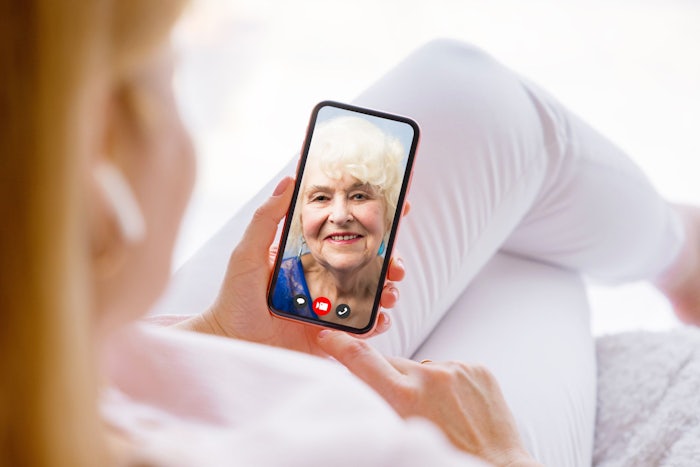How to help an older person use a smartphone
Learning how to use a phone is difficult, but being unable to hear or see anything on the device itself just makes it that much harder. Whether you need to hear a contact on the phone or need your contacts to see the screen, this guide will give you a few quick tips to top up your tech traits.
- Jump To Section:
- Font size and type •
- Using voice functionality •
- Using voice functionality •
- Emergency calling •
- Sound

Did you know that there are a range of accessibility options and quality of life changes which you can use to contour your device to suit your needs? (Source: Shutterstock)
Key points:
- Consider the sight, sound and emergency settings, along with potential safeguards for people who may be prone to memory loss as they age
- If you are considering purchasing a phone for an older person, consider an iPhone due to the uniform support available online, brick and mortar locations of Apple stores and general ease of changes to settings
- Notably, the emergency services SOS feature should be used in case of an active emergency where other options are unavailable
This edition of Aged Care Guide will focus on phones, with a particular focus on how to make them easier to use for an older person. As we age, we tend to be more forgetful, hard of hearing and/or may begin to experience issues with vision.
As such, this article will address things to change or set up when booting up a new smartphone device for the first time. These functions may also assist people who live with disability, as navigating the net, placing calls and reading messages can all serve as unique hurdles depending on the user.
Font size and type
For people with visual impairments or difficulties, the default text available when booting up a phone for the first time may be too small to see clearly. In addition, the font type may impact the readability of what is being displayed, either through general misleading or as a result of a disability such as dyslexia.
Depending on the type of device, locating the system settings and accessibility options may be difficult. For iPhone users, the following steps will assist in finding where to adjust fonts:
- Unlock your phone and arrive at the home screen, which shows many squares of apps
- Find and tap the settings icon on the iPhone’s home screen, which should look like a machine cog
- Tap accessibility
- Tap display & text size
- Choose the larger text option
- At the bottom of the screen, the slider will determine font size throughout the operating system (sliding left will reduce font size, whereas sliding to the right will increase font size)
For Android smartphones:
- Open settings
- Select display
- Select font size and style
- Opt for the font and size you would like to see on your operating system
Using voice functionality
Voice functionality on devices can help to take the stress and difficulty out of browsing the web, composing messages and finding relevant information to assist in day-to-day life. On iPhones, this function is called ‘Siri’.
Simply go to settings, then ‘siri & search,’ and listen for ‘hey, siri’ to use this feature. Asking Siri questions can yield results from the internet, with additional commands to access other apps or features on your phone. Having a contact bank in your phone, which lists the numbers or people and their names, can allow an older person to command Siri to arrange a phone call by asking.
Google Assistant, Amazon’s Alexa, Cortana and Samsung’s virtual assistant Bixby (available through the Android store) are all effectively capable of the same function.
Using voice functionality
Voice functionality on devices can help to take the stress and difficulty out of browsing the web, composing messages and finding relevant information to assist in day-to-day life. On iPhones, this function is called ‘Siri’.
Simply go to settings, then ‘siri & search,’ and listen for ‘hey, siri’ to use this feature. Asking Siri questions can yield results from the internet, with additional commands to access other apps or features on your phone. Having a contact bank in your phone, which lists the numbers or people and their names, can allow an older person to command Siri to arrange a phone call by asking.
Google Assistant, Amazon’s Alexa, Cortana and Samsung’s virtual assistant Bixby (available through the Android store) are all effectively capable of the same function.
Emergency calling
To turn on Emergency SOS calling for the iPhone, tap the settings cog and then select Emergency SOS which will enable you to link up a responder, along with share any relevant information which may be related to the emergency.
The same feature exists on Android phones under the safety category, with additional prompts to fill in personal details. A SIM card is needed to access emergency calling functionality.
Sound
The following features will help you address hearing impairments or issues with sound perception:
- Turn the ringer volume up
- Pair hearing aids with mobile device
- Familiarise the person with silent mode, health and alarms
Related content:
A guide to food delivery apps for seniors



![There are many websites available that provide resources to assist with making meals and provide information on nutrition. [Source: Shutterstock]](https://agedcareguide-assets.imgix.net/news/articles/wp/14_7_2021-Meals-and-shopping-assistance.jpg?fm=pjpg&w=162&h=124&q=80)
![Home care services can help you to live independently at home for longer. [Source: Shutterstock]](https://agedcareguide-assets.imgix.net/news/articles/wp/26_11_2021-home-care_211126_062404.jpg?fm=pjpg&w=162&h=124&q=80)
![All people receiving home care have rights relating to how that care is delivered. [Source: iStock]](https://agedcareguide-assets.imgix.net/news/articles/wp/19_10_2022-hc-rights_221019_094053.jpg?fm=pjpg&w=162&h=124&q=80)
![If you’re after government-funded support, you’ll need to be assessed. [Source: iStock]](https://agedcareguide-assets.imgix.net/news/articles/wp/ACATACAS__3010.jpg?fm=pjpg&w=162&h=124&q=80)
![Learning about how much it may cost you to receive aged care will help you to refine your fiscal planning. [Source: iStock]](https://agedcareguide-assets.imgix.net/news/articles/wp/nursinghomecosts__111.jpg?fm=pjpg&w=162&h=124&q=80)


